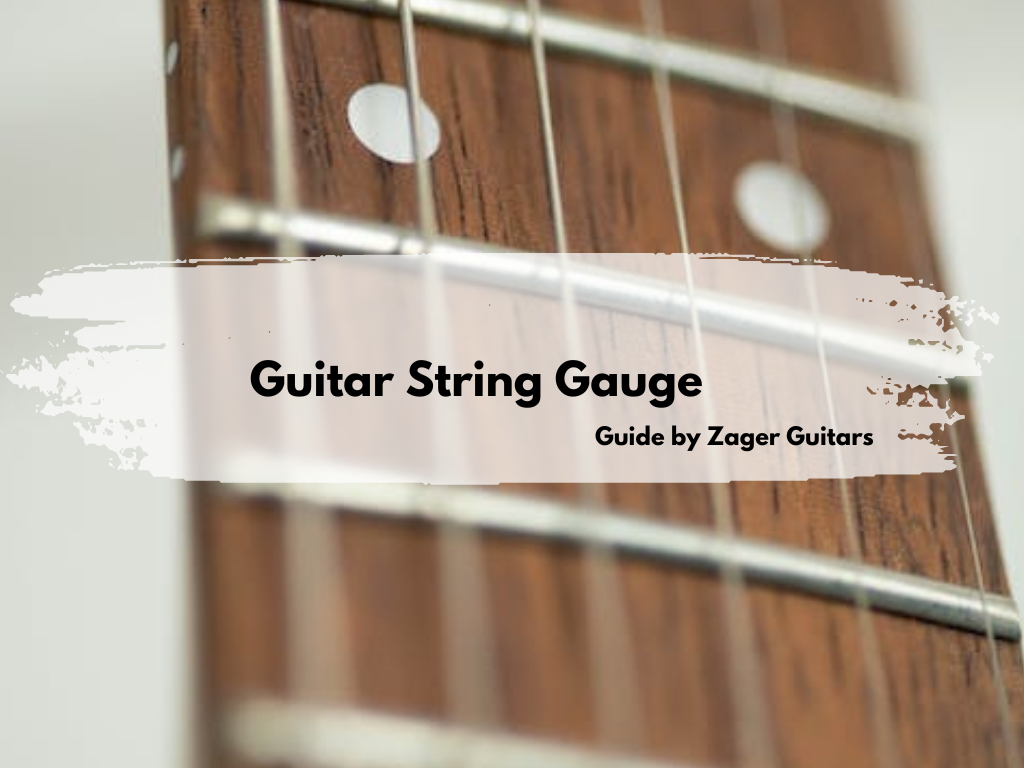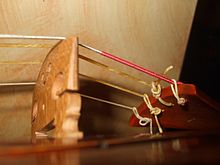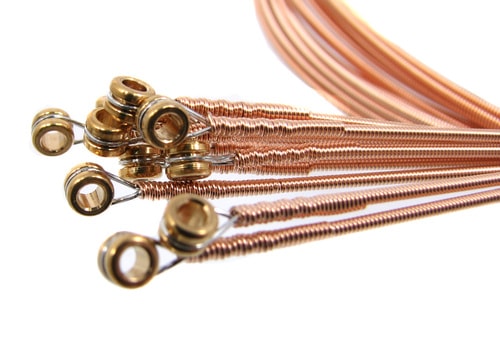Guitar String Gauge – A Guide By Zager

The sound is more than just strumming or plucking in guitars—it’s a magical symphony created by various factors. Whether you’re rocking out on an electric guitar or serenading with an acoustic, the distinctive sound you produce is influenced by a captivating interplay of wood, pickups, amplification, effects, and the choice of guitar strings.
Now, let’s dive into the world of guitar strings, where each one holds the power to shape your musical journey. Picture this: you’re faced with an array of light guitar strings together, each with its unique personality waiting to be unleashed. From the material they’re made of to the gauge that determines their thickness, every little detail contributes to the sonic tapestry you’re about to create.
Imagine the richness of a phosphor bronze string on an acoustic guitar, delivering warm, earthy tones that bring out the soul of your melodies. Or perhaps the brightness and sustain of nickel-plated steel strings on an electric guitar add that extra zing to your riffs and solos. The shape of the core and the way the lines are coated or wound further shape their sound, allowing you to explore a world of possibilities.
As you strum or pluck, the vibrations travel through those carefully chosen strings, resonating with your instrument and amplifying your emotions. Each note invites a sonic adventure, where the combination of wood, pickups, amplification, effects, and the unique properties of your chosen set of strings all blend to create a symphony that is distinctly yours.
So, whether you’re aiming for a soulful serenade or an electrifying performance, remember that the world of guitar strings is your palette, and every choice you make adds a brushstroke to your musical masterpiece. Embrace the journey, experiment with different lines, and let your sound soar to new heights, leaving a trail of awe-inspiring melodies in your wake. The stage is set, and the strings are waiting—go forth and make your music heard!
How Many Strings Do Guitars Have?
Guitars come in various configurations, offering different numbers of strings to suit diverse musical styles and preferences. While the standard guitar has six lines, other types deviate from this norm, creating new possibilities for musicians to explore.
Take the twelve-string guitar, for instance. With twice the number of strings as a standard guitar, this variation adds a new dimension to the sound. By doubling the pitches, often in unison or octaves, twelve-string guitars produce a rich and resonant tone, making them a favorite choice in genres like folk and country.
There are seven- and eight-string guitars for those seeking an even broader range. These instruments extend beyond the traditional six strings, offering additional lower pitches to complement the standard tuning. Popular among hard rock and progressive rock players, these guitars provide a more profound and heavier sound, with more tension and allowing for more complex chord voicings and intricate musical arrangements.
Meanwhile, the four-string configuration remains a classic choice in bass guitars. Tuned to E-A-D-G, these bass guitars lay down the foundation of the rhythm section. However, bass guitars have also embraced innovation, and you’ll find models with five or six strings becoming increasingly common. These additional strings allow bassists to explore lower registers or expand their melodic range, opening up new avenues for creativity and expression.
With guitars boasting diverse string counts, musicians can find the perfect match to suit their musical visions. Whether it’s the traditional six-string guitar, the shimmering resonance of a twelve-string, the expanded tonal palette of seven or eight-strings, or the low-end rumble of a multi-string bass, each variation brings its unique flavor to the world of music. So, string by string, let your creativity flow and discover the sonic possibilities that await you.
Electric Guitar String Materials
Metal is the game’s name for electric guitar and bass strings. These strings are crafted from various types of metals, and their vibrations are crucial to producing electrifying music. Let’s take a closer look at the three primary metals used in the manufacturing of electric guitar electric bass strings below:
Nickle Plated Steel

cc: C. B. Gitty
Nickel-plated steel is the most widely used material for electric guitar strings. With a coating of nickel on steel, these strings offer excellent resistance to corrosion while delivering a bright and cutting tone that can effortlessly slice through the mix when playing in a band setting.
Pure Nickel

cc: Dr. Strings
For guitarists seeking a more vintage or mellow sound, pure nickel strings are the way to go. They excel at taming some electric guitars’ sharp treble tones, especially when played in the bridge pickup position. Pure nickel strings offer a warm and smooth tonal character that resonates with those seeking a classic vibe.
Stainless Steel

cc: All This Guitar
As the name suggests, stainless steel strings are built to last. These strings have a longer lifespan compared to other styles, making them a popular choice for players who want durability. They also produce less finger squeak when sliding your hands up and down the guitar neck. However, it’s important to note that stainless steel strings have a bright tone, which may require tonal balancing, especially with treble-focused single coil pickups, but can be complemented by humbuckers.
So, whether you prefer the corrosion-resistant brightness of nickel-plated steel, the vintage warmth of pure nickel, or the longevity and reduced finger noise of stainless steel, each type of electric guitar string has unique characteristics. Experimenting with different materials allows guitarists to find the perfect match for their playing style and desired tone, ultimately electrifying their music with precision and style.
Acoustic Guitar String Materials
Catgut

cc: Catgut
Traditionally, guitar strings were made from the intestines of animals like sheep. Catgut strings were commonly used in the past, especially for classical guitars. Nowadays, technological advancements have made catgut strings less common, but you might still find them in select boutique music stores catering to classical guitarists.
Nylon
cc: SoundsFunny.org
Most classical guitars now utilize nylon strings for their top three lines. Nylon strings offer a warm, mellow tone that complements the classical guitar’s characteristics.
Nylon and Silver-plated Copper

cc: Amazon UK
Nylon and silver-plated copper: These strings combine a metal composite wrapped around a nylon core. They are typically used for the bottom three lines of a classical guitar, paired with nylon strings for the top three. This combination provides a balanced tonal quality, allowing for rich bass notes and clear treble tones.
Bronze

CC: Stringjoy
80/20 bronze: Bronze strings, specifically 80/20 bronze, are popular across various acoustic guitar styles. Some classical guitarists may use them for their lower three lines, while many folk and country acoustic guitarists prefer them for all six lines. 80/20 bronze strings offer a bright and vibrant tone, making them versatile for different musical genres.
Phosphor Bronze

cc: Stringjoy
Phosphor bronze: An evolution of 80/20 bronze, phosphor bronze strings incorporate a phosphor component that enhances string longevity while slightly reducing their natural brightness. These strings are highly favored by gigging musicians who seek consistent tone and durability high e string, minimizing the need for frequent restringing.
Silk and Steel
Silk and steel: Silk and steel strings are metal-wound silk or nylon strings. They produce a mellow and gentle sound, making them popular for the lower strings on classical guitars. These are flatwound strings provide a softer tone and are often preferred by players looking for a more relaxed and delicate playing experience.
By exploring the materials used in acoustic guitar strings, players can discover the unique qualities and tones that suit their guitar models and playing styles, whether classical, folk, country, or beyond.
Types of Guitar String Gauges
The tone of electric and acoustic guitars can be adjusted by changing the gauge of their strings. Thicker strings are suitable for strumming, while thinner, lighter gauge strings work well for fingerpicking. There are three commonly used string gauges:
Extra-light
In acoustic guitars, extra-light refers to strings with a gauge of .010 to .047 (measured in inches for the highest and lowest strings). Extra-light strings are usually .009 or even .008 gauge stringsstring except on the top string, also known as “custom-light” strings on electric guitars. They are known for being easy to play but have a higher tendency to break.
Light Strings
Light strings range from .012 to .053 gauge for acoustic guitars and .010 to .046 gauge for electric guitars. Light strings offer a balance between durability and a pleasant tone. They tend to last longer than extra-light or thick strings while maintaining a pleasing sound.
Medium Strings
Medium-gauge strings start at .013 for acoustic and .011 for electric guitars. They are thin strings and are commonly used in blues and rock genres, providing a substantial tone while allowing for some string bending.
Heavy Strings
Heavy-gauge strings start at .014 for acoustic and .012 for electric guitars. They are popular in jazz music, where a bass-forward guitar tone and minimal string bending are emphasized. Some rock and blues players also use heavy-gauge strings but detune their guitars by a half-step or whole-step to achieve a heavy tone with lines lighter gauge strings that are easier to bend. In acoustic guitar music, heavier strings produce more sustain and overtones, but they require greater finger strength from the player.
In conclusion, the choice of string gauge for electric and acoustic guitars significantly impacts the tone and playability of the instrument. Thicker strings, such as medium and heavy gauges, are favored for producing a fuller and more substantial tone.
They are often the same gauge preferred by blues, rock, and jazz musicians who seek a rich, bass-forward sound with minimal string bending. However, heavy-gauge strings may require more finger strength from the player.
On the other hand, thinner strings, including extra-light and very light gauge gauges, offer more effortless playability and are suitable for styles that involve strumming or intricate fingerpicking. They produce a brighter and more delicate tone, making them popular among acoustic and electric guitarists seeking a balanced sound with enhanced string-bending capabilities.
It is important to note that string gauges also influence durability, with lighter gauges generally being more prone to breaking. Finding the correct string gauge depends on individual playing styles, musical genres, and personal preferences.
Experimentation with different gauges can help guitarists discover the balance between playability, tone, and durability to suit their needs.
FAQs
What gauge is a standard guitar string?
String Gauge. Almost all new electric guitars feature 12-gauge strings. February 06, 2016.
How do I choose guitar string gauges?
While string gauge varies depending on tone and sensation, most brands suggest string gauge based on the string size. This is primarily because of the strings’ strain on the guitar top. The greater the size the string sets the body will absorb, the higher the strain it withstands. 21 September 2019.
Are 11 gauge strings hard to play?
Custom or Super light meters (10-12-2). Super soft gauge strings (sometimes called custom light gauges) are slightly larger than lighter 10 gauge strings, though still very easily playable and allow for simple twisting. 2021.
